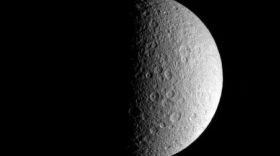-
Strange Universe With Bob BermanIt can be tricky to pinpoint the spot directly overhead in the sky, but, you can find it by looking for Deneb, a bright star nearly at the zenith. While not as brilliant as nearby Vega, Deneb is one of the most luminous stars in the sky, shining with the power of 58,000 Suns from 1,500 light-years away. If it were as close as Sirius, its light would outshine our streetlights. Deneb is also significant because it lies in the direction Earth is moving as the Sun carries us around the galaxy at 144 miles per second. Though we’ll never catch it—it’s moving too—it’s still a powerful feeling to look up and point toward the future.
-
Strange Universe With Bob BermanSaturn Made Easy: Saturn is a stunning sight through any telescope with more than 30x magnification—something photos can’t quite capture. It’s usually hard to spot, dimmer than Jupiter or Venus and less colorful than Mars, but now is the perfect time to see it. Saturn is closest to Earth and visible just below the Moon. Its famous rings, currently angled edgewise—a rare view that happens only every 15 years—appear as a straight bright line across the planet. Finding Saturn is easy: just look for the Moon.
-
Strange Universe With Bob BermanUntil the 20th century, astronomers ignored the interiors of things. They had to. Telescopes only showed outermost layers.Scientists knew that a ball's "inside" constitutes virtually all its mass, but basic questions went unanswered: What, for example, lay below the dazzling solar surface? What mysteries might be found in the core of galaxies?
-
Strange Universe With Bob BermanThis year brings a rare lunar event called the Lunar Standstill, which happens only once every 18.5 years. Due to the Moon’s wobbling orbit aligning with Earth’s tilt, the Moon is reaching extreme positions in the sky. Recently, it appeared unusually low at first quarter, the third quarter Moon stood directly overhead—something typically impossible from the continental U.S. Even in daylight, the Moon remains high and visible, especially through sunglasses, offering a striking sight in the sky.
-
Strange Universe With Bob BermanVega, one of the brightest stars, is often mispronounced as "VAY-ga" but should be "WEE-ga," meaning "falling eagle" in Arabic. Visible at nightfall, it shines blue overhead, contrasting with the orange Arcturus. Located 25 light-years away, it’s 58 times brighter than the sun and spins much faster, completing a rotation in just 11 hours. In 12,000 years, Vega will become Earth's pole star. It also displays a rare blueshift, pointing to the direction we're traveling in space.
-
Strange Universe With Bob BermanThis week’s half Moon will appear unusually low in the sky—so low it might be hidden behind the trees. It sits far below its usual path due to the Moon’s wobbling orbit, which currently aligns with Earth’s tilt. This rare positioning, part of a cycle called the Lunar Standstill, places the Moon near the constellation Scorpius and its bright star Antares. Its light, filtered through thick atmosphere, may appear honey-colored and cast moonbeams at odd angles into places that rarely see moonlight. Look south to see this striking celestial oddity.
-
Strange Universe With Bob BermanArcturus: A Star Worth Saluting: On the next clear evening around 8 p.m., look west and halfway up the sky—you’ll spot Arcturus, a bright pastel-orange star and the fourth brightest we can see from Earth. It once famously opened the 1933 Chicago World's Fair with its light and is unique among bright stars for its wild, plunging path through space. Unlike stars that circle with the Milky Way, Arcturus is just passing through—so catch a glimpse while you can. It's the brightest thing in tonight’s sky… and it won’t be there forever.
-
Strange Universe With Bob BermanOn Wednesday, July 23, we saw a rare cosmic pairing as the Moon passes unusually close to Spica, the brilliant blue star in Virgo. Thanks to a unique tilt in the Moon’s orbit — an event that won’t repeat until 2043 — this striking alignment becomes visible to the naked eye. Learn why Spica shines so hot and bright, and how to pronounce its name the right way. Look up between 9:30 and 10 p.m. for a glimpse of this fleeting spectacle.
-
Strange Universe With Bob BermanTwelve years ago, NASA's Curiosity rover journeyed to Mars with instruments that measured space radiation for the first time en route. The findings were sobering: astronauts would face radiation doses equivalent to a full-body CT scan every few days—raising cancer risks by 3–4% on the trip alone. Most of this came from galactic cosmic rays, which spacecraft walls can’t block. And this didn’t even include the added threat of solar storms. To send humans safely to Mars, solving the radiation challenge is essential.
-
Strange Universe With Bob BermanSet your alarm early this week and look east between 5:00 and 5:30 a.m. to catch a stunning celestial display. Brilliant Venus, the Morning Star, shines high with the bright orange star Aldebaran glowing below. Aldebaran, part of the V-shaped Hyades cluster in Taurus, has a rich astronomical legacy—its position once helped confirm Einstein’s theory of General Relativity. Nearby, you’ll also spot the shimmering Pleiades cluster. Together, these stars create a breathtaking, layered view of the cosmos worth waking up for.

Play Live Radio
Next Up:
0:00
0:00
Available On Air Stations










